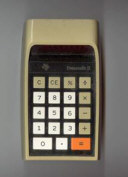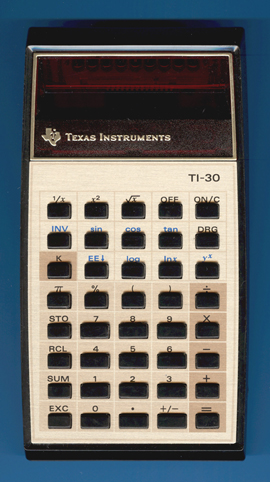
DATAMATH CALCULATOR MUSEUM
 |
DATAMATH CALCULATOR MUSEUM |
Texas Instruments TI-30
| Date of introduction: | June 13, 1976 | Display technology: | LED-stick |
| New price: | $24.95, £14.95 | Display size: | 8 (5 + 2) |
| Size: | 5.8" x 3.1" x
1.4" 148 x 78 x 36 mm3 |
||
| Weight: | 4.0 ounces, 114 grams | Serial No: | 6631991 |
| Batteries: | 9V or RK2 | Date of manufacture: | wk 46 year 1976 |
| AC-Adapter: | AC9132, AC9182 | Origin of manufacture: | USA |
| Precision: | 10 | Integrated circuits: | TMC0981 |
| Logic: | AOS - 4 Pending Operations, 15 () | ||
| Memories: | 1 | ||
| Program steps: | Courtesy of: | Joerg Woerner | |
| Download leaflet: | |
Download manual: | |

![]() The
TI-30 was introduced mid of 1976 together with the SR-40
and the financial calculator Business Analyst.
With a SRP of $24.95 compared to the $49.95 of a fully
equipped SR-40 the TI-30 was a great success. Probably the best selling calculator
ever with about 15,000,000 manufactured units between 1976 and 1983.
The
TI-30 was introduced mid of 1976 together with the SR-40
and the financial calculator Business Analyst.
With a SRP of $24.95 compared to the $49.95 of a fully
equipped SR-40 the TI-30 was a great success. Probably the best selling calculator
ever with about 15,000,000 manufactured units between 1976 and 1983.
 Inside the TI-30 is identically to the SR-40, the massive cost
reduction was the sum of two details: The rechargeable battery pack was replaced
by a simple 9V cell and the molded lettering of the colored keys replaced by a
printed key plate. Battery consumption of the TI-30 was horrible, marketing guys
from TI invented the after market sales of "Rechargeable Kits" RK1
and RK2 ($10.95). They used one or two AA-cells and a
step-up converter to generate the 9V of the TI-30.
Inside the TI-30 is identically to the SR-40, the massive cost
reduction was the sum of two details: The rechargeable battery pack was replaced
by a simple 9V cell and the molded lettering of the colored keys replaced by a
printed key plate. Battery consumption of the TI-30 was horrible, marketing guys
from TI invented the after market sales of "Rechargeable Kits" RK1
and RK2 ($10.95). They used one or two AA-cells and a
step-up converter to generate the 9V of the TI-30.
The electronics of
the SR-40 is centered around a TMC0981 circuit, a member of the
TMC0980
single-chip calculator family, while the TI-45 uses a chip from the
TMC1980
family. Both designs are based
on the TMS1000 Microcomputer
series with an increased memory capacity of 18,432 Bits Read-Only Memory (ROM, 2k*9 Bits) and 576 Bits Random-Access Memory (RAM, 9 Registers * 16 digits). Main differences between the TMC0980 and TMC1980 are the display
drivers - while the former supports LED displays, adds the latter high-voltage
drivers for Vacuum Fluorescent Displays (VFD). In addition includes the TMC1980 both an integrated charge pump driver to generate the high voltage (around -22V) for the Anodes and Grids of the VF-Display and integrated drivers for the Filament (heater)
allowing for reasonable manufacturing costs.
Another option was the use of the AC9182 AC-Adapter providing
9V DC with an outlet like a 9V battery.
Three simulated vinyl cases were available ($3.95 each) to protect the calculator:
| • Blue Denim • Tan Suede • Rust Corduroy |
Texas Instruments introduced the revolutionary Algebraic Operating System (AOS™) in September 1975 with their flagship Programmable calculator SR-52 but this SR-40 and its sibling TI-30 brought it to the masses. And consequently created a nightmare for TI's Portfolio Manager of Scientific calculators...
A similar version of the TI-30 was sold under the German
Privileg label. Please view the SR-35NC.
The German TI-33 lacked the AOS system. In Europe some
TI-30 using a different display screen were sold, don't miss the 1st Italy
design of the TI-30.
In the meantime we discovered a rare TI-30 with a
completely different keyboard technology. The TI-30
manufactured in Brazil looks identical but varies the calculator chip slightly.
Don't miss the rare TI-30/super
manufactured for Koh-I-Noor
Hardtmuth and the colorful SILCA
48.
Simply by comparing the designation of the integrated circuits of the entry line "Majestic" calculators, you'll get the all members of this family:
|
• TMC0980
Goulds
Pumpulator uses a custom design ROM (CD9801) Digging deeper into the TMC098x calculator chips you'll locate an OEM-chip used on a TI-30 "clone" manufactured in Hong Kong: • TMC0985 Amelia Scientific 2001 |
Later in production of the Majestic-line calculators the metallized TI logo was changed to lower manufacturing costs. View here the TI-30 w/o chrome.
![]() Press the X-RAY button and view the
internals of a TI-30.
Press the X-RAY button and view the
internals of a TI-30.
(Pictures provided by Edward Soudentas)
It took 5 years before the keyboard layout of the TI-30 appeared again with a LCD calculator. View the TI-30-II. In the meantime LCD calculators like the TI-25 or the TI-50 appeared.
If we call the TI-30 based calculators "entry line" we should name the TI-55 "advanced line".
You like this housing ? Don't miss the TM 990/301 Microterminal.
Don't miss the TI-30 for the vision impaired people, the Schoenherr Braillotron.
|
TI-30. Extended capability calculator with memory, scientific notation. TI’s unique AOS™ algebraic operating system makes the TI-30 calculator especially useful to secondary students. Problems are entered left-to-right and are executed following standard algebraic hierarchy: First powers, Then multiplication and division, And finally, addition and subtraction. There’s no special entry sequence to learn; thus, students can focus on the mathematical concepts and their application. A bright 8-digit display indicates negative sign, overflow and underflow, and in scientific notation indicates 5 digits plus 2-digit exponent. Its powerful slide-rule features and keys are ideal for throughout the high school curriculum: memory system for storing intermediate results, up to four pending operations enclosed in up to 15 sets of parentheses, [DRG], [x2], [SQR x], [1/x], [INV], [sin], [cos], [tan], [K], [EE], [log], [lnx], [yx] and [%]. “Calculator Math™ Introductory Algebra”, a supplemental mathematics learning program, was developed by the University of Denver ’s Mathematics Laboratory for use with the TI-30 in secondary classes. A challenging and informative book, The Great International Math on Keys Book, is also available for use with the TI-30. Its 224 pages of valuable operating tips, math fact, useful formulas, puzzles and games are of particular relevance to high school students. © Texas Instruments, 1976 |
| TI-30 Student Math Kit
Economical problem-solving kit with scientific calculator. Developed with the cooperation of nationally known educators, this calculator-based math system is designed to meet the needs of today’s students. As skills grow through high school to college and into career, the TI-30 Student Math Kit will continue to meet the more advanced math challenges. © Texas Instruments, 1981 |
AOS™ is a trademark of Texas Instruments.
If you have additions to the above article please email: joerg@datamath.org.
© Joerg Woerner, December 5, 2001. No reprints without written permission.